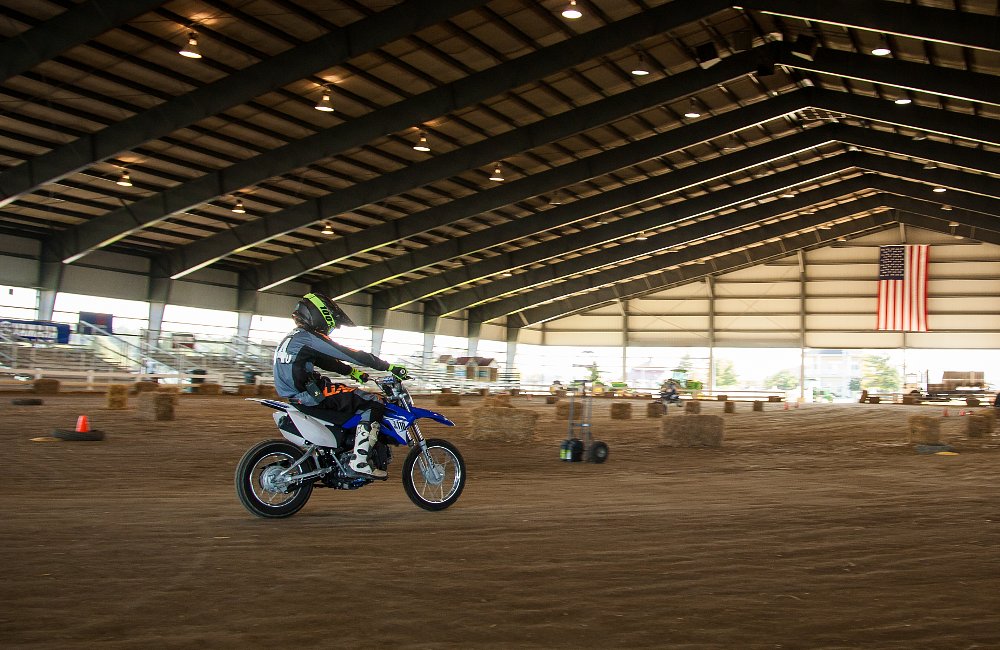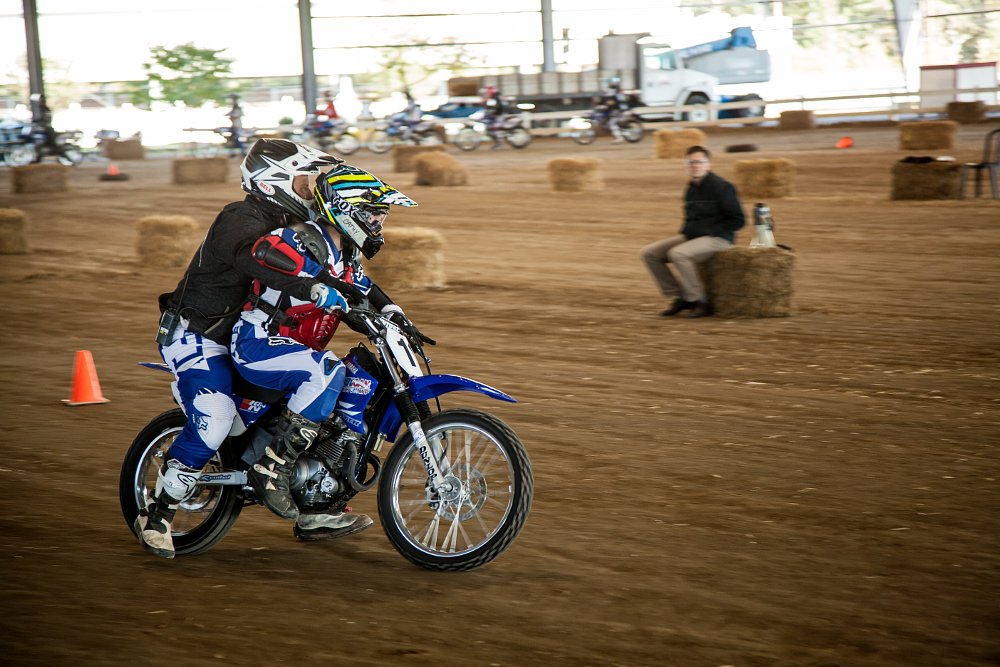“There are a thousand ways to ride a motorcycle. I am just going to teach you one of those ways.”
Danny Walker stood in front of the classroom as he addressed students ranging in age from grade school to retirement. In this case, the “classroom” consisted of aluminum bleachers in the Quillen Arena located on the Delaware State Fairgrounds. As 30 riders sat listening to a speech that Danny has been perfecting over the past 20 years, the excitement of American Supercamp began to settle in.

If you’re not familiar, American Supercamp is a traveling riding academy that teaches students the finer points of riding in the dirt. The flat-track skills that riders learn here translate to improvements on the street, the trails or the track.
For riders who want to improve their skills but don’t have access to a dirt bike, the cost of admission includes the use of a Yamaha TT-R 125 as well as dirt riding gear, if you don’t have your own. This is different from some of the other classes I have taken in the past where riders either have to supply their own bikes and gear or pay extra to rent them.

I spent two days at American Supercamp, breaking down the importance of body position, braking, and throttle control for riding fast in the dirt. Here are a few of the bigger takeaways I brought home with me from a weekend of riding in circles with Danny and his crew.
“Crack to crack”
This refers to placing the crack of your butt on the outside crack of the seat. Unlike road racing or street riding, where you lean into the curve with the motorcycle, off-road riding requires the rider to sit up straight, keeping your upper body perpendicular to the ground while the bike moves underneath you.

“Think of a duck on the water,” Danny said, while doing what must have been his idea of a duck impersonation. “On the surface, the duck looks calm and collected, while underneath his legs are paddling non-stop.”
His main goal for this school is to get students comfortable with the bike sliding around underneath them. The focus is on letting your hips (and everything below them) pivot and sway while everything north of your pelvis stays vertical and settled.
This goes against everything we have ever been taught while street riding. I learned very quickly that the success students achieve at American Supercamp correlates directly with their ability to break old habits and adopt new ones.
“Point to the ground”
Once on the motorcycle, you want to move your weight as close to the tank as possible. You will find yourself sitting up on the tank with the crotch of your pants against the plastic while slouching your shoulders down and back like a sullen teenager. The further you slouch, the better you ride. This goes against years of parenting where my mom insisted I sit up straight.

While you’re sitting up on the tank, shoulders slouched, you then extend your inside arm, pushing the bike down underneath you in the direction you wish to go while raising your outside elbow toward the sky. Essentially you are pointing to the ground in the direction of the turn while opening your hips into the corner and digging your outside knee into the tank. Combine this with “crack to crack” and your form will start taking shape.
This was all easier said than done as most of us have a predisposition to sitting up straight (or forward) and leaning into curves. I kept getting hit with a stick as the instructors screamed at me to slouch down and get my outside elbow up.
“Look where you want to go”
Sounds simple, right? This one should be self explanatory to anyone driving a car or riding a motorcycle. However, when I attended California Superbike School they spent an entire day focused on where you should be looking while navigating a corner. Danny and his team addressed it with every drill we performed. This is one of the hardest skills for new and veteran riders to grasp.
Remember, the motorcycle goes where you tell it to go and that’s always where you should be looking. If you find yourself looking at the ground or at that hay bale in the corner you don’t want to hit, guess what you’re going to hit? Both.

Navigating through tight corners, you should already be looking behind you, back through the corner before you even finish your braking. This was one of the hardest skills for a lot of students to get the hang of, especially if they weren’t used to riding with other motorcyclists around them. These folks struggled, looking at the backs of the other riders, which usually ended in a crash. Some of the hardheaded students earned themselves a series of pushups every time an instructor caught them looking in the wrong direction.
“Dance with the bike”
In order to navigate the corner correctly, body positioning, braking, and acceleration all have to work together and be executed smoothly.

“You’re not going all WWE on the bike, slamming it and wrestling it around,” Danny explained, “No, you’re dancing with it!”
Danny and his team break down the art of cornering in the dirt into four steps:
- Drive the bike into the corner
- Reduce speed
- Change direction
- Start accelerating straight-away
For step one, you have to stay on the gas later into the corner than what you would normally expect. This is the biggest problem students have to overcome and it was one that I struggled with, as well. You have to carry enough speed into the corner to allow the bike to make it all the way around the turn while braking. Entering into step two, riders need to throttle down while applying the rear brake slowly.

“You’re squeezing the brake, not slamming it, not locking it up,” Danny said with a laugh. “Pretend there is a raw egg underneath your pedal and you don’t want to break it.”
With the rear brake engaged and the throttle backed off, you transition into step three, pushing the bike down and into the corner. You’re not countersteering the bike as you would on the street. Rather, you are physically turning the wheel and pushing the front end in the direction you want to go, maximizing lean angle.
Once the bike is turned, you can begin step four and engage the throttle, slowly, building up speed as lean angle decreases. The biggest takeaway here is being extremely smooth with all of the controls. Don’t chop the throttle or slam on the brake. Doing so will have you kissing the dirt and it’ll leave the instructors laughing at your expense. The majority of my crashes were low-sides from accelerating out of a corner too quickly.
If executed correctly, you can make the bike do damn near whatever you would like, as demonstrated by one of our instructors, Sac, “dancing” through a corner at the 1:30 mark in this video:
Danny founded American Supercamp to get riders more comfortable with their machines and thus improve their riding skills. He and his crew are a friendly, likeable group of riders who encourage students to crash bikes they don't own and learn from their mistakes in a safe and controlled environment.

From eight years old to 80 years old, you are never too young, or too old, to learn something new. I left with a better sense of control and understanding of how to make the motorcycle do what I want it to do. I look forward to translating these skills into my regular riding.
I met expert-level roadracers hoping to learn skills to use on the track and retired guys looking to pick up a new hobby. There were folks there who had never even touched a dirt bike before as well as a young woman who had just completed the MSF course the week before and wanted to gain more experience on a motorcycle before hitting the highway. Whatever the reason, there is no such thing as too much education.
When there are a thousand ways to ride a motorcycle, it can’t hurt to learn one more. Especially when school is this much fun.















